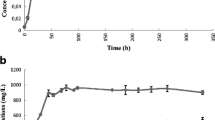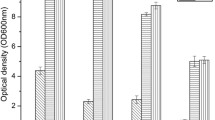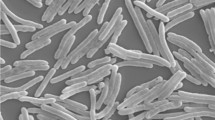Abstract
Butanol production from carbon monoxide-rich waste gases or syngas is an attractive novel alternative to the conventional acetone-butanol-ethanol (ABE) fermentation. Solvent toxicity is a key factor reported in ABE fermentation with carbohydrates as substrates. However, in the gas-fermentation process, kinetic aspects and the inhibition effect of solvents have not thoroughly been studied. Therefore, different batch bottle experiments were carried out with the bacterial species Clostridium carboxidivorans using CO as carbon source for butanol-ethanol fermentation. A maximum specific growth rate of 0.086 ± 0.004 h−1 and a biomass yield of 0.011 gbiomass/gCO were found, which is significantly lower than in other clostridia grown on sugars. Besides, three assays were carried out to check the inhibitory effect of butanol, ethanol, and their mixtures. Butanol had a higher inhibitory effect on the cells than ethanol and showed a lower IC50, reduced growth rate, and slower CO consumption with increasing alcohol concentrations. A concentration of 14–14.50 g/L butanol caused 50 % growth inhibition in C. carboxidivorans, and 20 g/L butanol resulted in complete inhibition, with a growth rate of 0 h−1. Conversely, 35 g/L ethanol decreased by 50 % the final biomass concentration respect to the control and yielded the lowest growth rate of 0.024 h−1. The inhibitory effect of mixtures of both alcohols was also checked adding similar, near identical, concentrations of each one. Growth decreased by 50 % in the presence of a total concentration of alcohols of 16.22 g/L, consisting of similar amounts of each alcohol. Occasional differences in initially added concentrations of alcohols were minimal. The lowest growth rate (0.014 h−1) was observed at the highest concentration assayed (25 g/L).




Similar content being viewed by others
References
Abdehagh N, Tezel FH, Thibault J (2014) Separation techniques in butanol production: challenges and developments. Biomass Bioenerg 60:222–246. doi:10.1016/j.biombioe.2013.10.003
Abubackar HN, Veiga MC, Kennes C (2011) Biological conversion of carbon monoxide-rich syngas or waste gases to bioethanol. Biofuels Bioprod Biorefin 5:93–114. doi:10.1002/bbb.256
Abubackar HN, Veiga MC, Kennes C (2015) Carbon monoxide fermentation to ethanol by Clostridium autoethanogenum in a bioreactor with no accumulation of acetic acid. Bioresour Technol 186:122–127. doi:10.1016/j.biortech.2015.02.113
Balat M, Balat H (2009) Recent trends in global production and utilization of bio-ethanol fuel. Appl Energ 86(11):2273–2282. doi:10.1016/j.apenergy.2009.03.015
Barber JM, Robb FT, Webster JR, Woods DR (1979) Bacteriocin production by Clostridium acetobutylicum in an industrial fermentation process. Appl Environ Microbiol 37:433–437
Bellido C, Pinto ML, Coca M, González-Benito G, García-Cubero MT (2014) Acetone-butanol-ethanol (ABE) production by Clostridium beijerinckii from wheat straw hydrolysates: efficient use of penta and hexa carbohydrates. Bioresour Technol 167:198–205. doi:10.1016/j.biortech.2014.06.020
Bowles LK, Ellefson WL (1985) Effects of butanol on Clostridium acetobutylicum. Appl Environ Microbiol 50:1165–1170
Costa JM, Moreira AR (1983) Growth kinetics of the acetone-butanol fermentation. In: Blanch HW, Papoutsakis ET, Stephanopoulos G (eds) Foundations of biochemical engineering, kinetics and thermodynamics in biological systems, ACS symposium series 207. American Chemical Society, Washington DC, pp. 501–504
Dürre P (2007) Biobutanol: an attractive biofuel. Biotechnol J 2:1525–1534. doi:10.1002/biot.200700168
Fernández-Naveira Á, Abubackar HN, Veiga MC, Kennes C (2016) Efficient butanol-ethanol (B-E) production from carbon monoxide fermentation in Clostridium carboxidivorans. Appl Microbiol Biotechnol. doi:10.1007/s00253-015-7238-1
Goldstein DB (1986) Effect of alcohol on cellular membranes. Ann Emerg Med 15(9):1013–1018. doi:10.1016/S0196-0644(86)80120-2
Gottwald M, Gottschalk G (1985) The internal pH of Clostridium acetobutylicum and its effect on the shift from acid to solvent formation. Arch Microbiol 143:42–46
Gowen CM, Fong SS (2011) Applications of systems biology towards microbial fuel production. Trends Microbiol 10:516–524. doi:10.1016/j.tim.2011.07.005
Jones DT, Woods DR (1986) Acetone–butanol fermentation revisited. Microbiol Rev 50:484–524
Kennes C, Veiga MC (2013) Air pollution prevention and control: bioreactors and bioenergy. J. Wiley & Sons, Chichester, United Kingdom, 549 pp
Kennes D, Abubackar HN, Diaz M, Veiga MC, Kennes C (2016) Bioethanol production from biomass: carbohydrate vs syngas fermentation. J Chem Technol Biotechnol 91:304–317. doi:10.1002/jctb.4842
Koepke M, Liew F, Simpson SD (2012) Recombinant microorganisms with increased tolerance to ethanol. Patent application WO2012105853 A1
Leboulanger C, Rimet F, de Lacotte MH, Berard A (2001) Effects of atrazine and nicosulfuron on freshwater microalgae. Environ Int 26:131–135. doi:10.1016/S0160-4120(00)00100-8
Lee SY, Park JH, Jang SH, Nielsen LK, Kim J, Jung KS (2008) Fermentative butanol production by clostridia. Biotechnol Bioeng 101:209–228. doi:10.1002/bit.22003
Leung JCY, Wang DIC (1981) Production of acetone and butanol by Clostridium acetobutylicum in continuous culture using free cells and immobilized cells. Proc 2nd World Congr Chem Eng 1:348–352
Liou JSC, Balkwill DL, Drake GR, Tanner RS (2005) Clostridium carboxidivorans sp. nov., a solvent-producing clostridium isolated from an agricultural settling lagoon, and reclassification of the acetogen Clostridium scatologenesstrain SL1 as Clostridium drakei sp. nov. Int J Syst Evol Microbiol 55:2085–2091. doi:10.1099/ijs.0.63482-0
Liu S, Qureshi N (2009) How microbes tolerate ethanol and butanol. New Biotechnol 26:117–121. doi:10.1016/j.nbt.2009.06.984
Moreira AR, Ulmer DC, Linden JC (1981) Butanol toxicity in the butylic fermentation. Biotechnol Bioeng Symp 11:567–579
Napoli F, Olivieri G, Russo ME, Marzocchella A, Salatino P (2012) Continuous lactose fermentation by Clostridium acetobutylicum—assessment of energetics and product yields of the acidogenesis. Enzyme Microb Technol 50:165–172. doi:10.1016/j.enzmictec.2011.11.003
Papoutsakis ET (2008) Engineering solventogenic clostridia. Curr Opin Biotechnol 19:420–429. doi:10.1016/j.copbio.2008.08.003
Qureshi N, Meagher MM, Huang J, Hutkins RW (2001) Acetone butanol ethanol (ABE) recovery by pervaporation using silicalite–silicone composite membrane from fed-batch reactor of Clostridium acetobutylicum. J Membr Sci 187:93–102. doi:10.1016/S0376-7388(00)00667-0
Srivastava AK, Volesky B (1990) Updated model of the batch acetone-butanol fermentation. Biotechnol Lett 12:693–698. doi:10.1007/BF01088196
Tanner RS (2007) Cultivation of bacteria and fungi. In: Hurst CJ, Crawford RL, Garland JL, Lipson DA, Mills AL, Stetzenbach LD (eds) Manual of environmental microbiology. ASM Press, Washington D.C., pp. 69–78
Ukpong MN, Atiyeh HK, De Lorme JM, Liu K, Zhu X, Tanner RS, Wilkins MR, Stevenson BS (2012) Physiological response of Clostridium carboxidivorans during conversion of synthesis gas to solvents in a gas-fed bioreactor. Biotechnol Bioeng 109:2720–2728. doi:10.1002/bit.24549
Van der Westhuizen A, Jones DT, Woods DR (1982) Autolytic activity and butanol tolerance of Clostridium acetobutylicum. Appl Environ Microbiol 44:1277–1282
Wallner T, Miers SA, McConnell S (2009) A comparison of ethanol and butanol as oxygenates using a direct-injection, spark-ignition engine. J Eng Gas Turbines Power 131:032802–1–032802-9. doi:10.1115/1.3043810
Woods DR (1995) The genetic engineering of microbial solvent production. Trends Biotechnol 13:259–264. doi:10.1016/S0167-7799(00)88960-X
Acknowledgments
This research was financially supported by the Spanish Ministry of Economy and Competitiveness (MINECO) as well as European FEDER funds, through project CTM2013-45581-R.
Author information
Authors and Affiliations
Corresponding author
Ethics declarations
Funding
This study was financed by the Spanish Ministry of Economy and Competitiveness (MINECO) and through European FEDER funds.
Conflict of interest
The authors declare that they have no conflict of interest.
Human and animal rights
This article does not contain any studies with human participants or animals performed by any of the authors.
Rights and permissions
About this article
Cite this article
Fernández-Naveira, Á., Abubackar, H.N., Veiga, M.C. et al. Carbon monoxide bioconversion to butanol-ethanol by Clostridium carboxidivorans: kinetics and toxicity of alcohols. Appl Microbiol Biotechnol 100, 4231–4240 (2016). https://doi.org/10.1007/s00253-016-7389-8
Received:
Revised:
Accepted:
Published:
Issue Date:
DOI: https://doi.org/10.1007/s00253-016-7389-8




